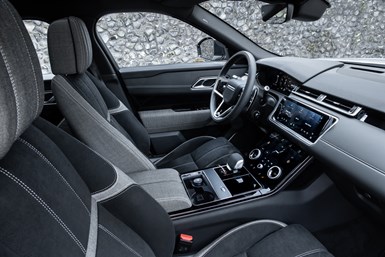JLR to Use Recycled Plastic in Car Interiors
Putting your feet down on CO2 savings
#interior
Jaguar Land Rover is casting a wide sustainability net.

2021 Jaguar Velar with Kvadrat (Image: JLR)
Under its Destination Zero initiative, the carmaker will begin using recycled plastics in the floormats and interior trim of future vehicles.
The new interior applications are part of JLR’s efforts to offer more environmentally friendly alternatives to traditional interior materials, without sacrificing performance or the “luxurious feel” Jaguar and Land Rover vehicles are known for.
Waste Not
The green interior components will be made from Econyl nylon supplied by Italian synthetic fiber specialist Aquafil.

Used fish netting (Image: Aquafil/JLR)
Already used in the production of high-end handbags, sportswear and luxury watch straps, Econyl is regenerated from recycled industrial plastic, fishing nets and fabric offcuts from clothing manufacturers.

The salvaged nylon is treated in a chemical plant and broken down into raw materials via a depolymerization process, then turned into Aquafil’s Econyl yarn. By-products such as non-nylon, metallic materials and copper sulphate (used for preventing seagrass growing on fishing nets) are removed and sent for reuse in other applications.
The recycled Econyl nylon polymer has the same chemical and performance characteristics as raw fossil material, according to JLR.
Tons of Savings
Aquafil recycles about 40,000 metric tons of waste per year.

Using the Econyl reduces greenhouse gases by 90% compared with those generated by nylon derived from oil, the company claims. This equates to avoiding 65,100 metric tons of carbon emissions for every 10,000 tonnes of ECONYL raw material produced, which Aquafil says is equivalent to that generated from 70,000 barrels of crude oil.
More Green Stuff
The new Econyl fabric is joined by several other green materials available in JLR vehicles. These include a eucalyptus-based textile used Kvadrat—a durable wool/suede cloth partially made from recycled plastic bottles (53 per vehicle) in the Range Rover Evoque, Range Rover and Jaguar’s all-electric I-Pace.
RELATED CONTENT
-
on lots of electric trucks. . .Grand Highlander. . .atomically analyzing additive. . .geometric designs. . .Dodge Hornet. . .
EVs slowdown. . .Ram’s latest in electricity. . .the Grand Highlander is. . .additive at the atomic level. . .advanced—and retro—designs. . .the Dodge Hornet. . .Rimac in reverse. . .
-
On Electric Pickups, Flying Taxis, and Auto Industry Transformation
Ford goes for vertical integration, DENSO and Honeywell take to the skies, how suppliers feel about their customers, how vehicle customers feel about shopping, and insights from a software exec
-
Ford Copies Nature
As Nature (yes, capital N Nature) has done a pretty good job of designing things, it is somewhat surprising that Man (ditto) doesn’t follow Nature’s lead more often when it comes to designing objects.








